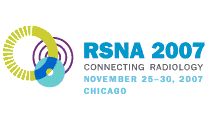
Abstract Archives of the RSNA, 2007
SSA15-01
Development of Computerized Nodule Detection Scheme on Thin-slice CT: Effect of Nodule Size and Pattern Group on Its Performance
Scientific Papers
Presented on November 25, 2007
Presented as part of SSA15: Physics (Thoracic CAD )
Qiang Li PhD, Presenter: Patent agreement, General Electric Company
Patent agreement, Toshiba Corporation
Patent agreement, R2 Technology, Inc
Patent agreement, Deus Technologies, LLC
Patent agreement, Riverain Medical
Patent agreement, MEDIAN Technologies
Patent agreement, Mitsubishi Corporation
Consultant, Riverain Medical
Feng Li MD, PhD, Abstract Co-Author: License agreement, Hologic, Inc (R2 Technology, Inc)
License agreement, Deus Technologies, LLC
License agreement, Riverain Medical
License agreement, Mitsubishi Corporation
License agreement, MEDIAN Technologies
License agreement, General Electric Company
License agreement, Toshiba Corporation
Kunio Doi PhD, Abstract Co-Author: Shareholder, Hologic, Inc (R2 Technology, Inc)
License Agreement, Hologic, Inc (R2 Technology, Inc)
License Agreement, Deus Technologies, LLC
License Agreement, Riverain Medical
License Agreement, Mitsubishi Corporation
License Agreement, MEDIAN Technologies
License Agreement, General Electric Company
License Agreement, Toshiba Corporation
Research Support, Deus Technologies, LLC
Research Support, DuPont
Research Support, Elbit Medical Imaging Ltd
Research Support, Fuji Photo Film Co, Ltd
Research Support, General Electric Company
Research Support, Hitachi, Ltd
Research Support, Eastman Kodak Company
Research Support, Konica Minolta Group
Research Support, Mitaya Manufacturing Co, Ltd
Research Support, Mitsubishi Corporation
Research Support, Koninklijke Philips Electronics NV
Research Support, Hologic, Inc (R2 Technology, Inc)
Research Support, Riverain Medical
Research Support, Seiko Corporation
Research Support, Siemens AG
Research Support, 3M Company
Research Support, Toshiba Corporation
To develop a computer-aided diagnostic (CAD) scheme for detection of lung nodules in CT and to investigate its performance levels for nodules in different size and pattern groups.
Our database consisted of 117 thin-slice CT scans with 153 nodules obtained at Shinshu University, Japan (85 scans, 91 nodules, including 41 cancers and 50 benign nodules) and the University of Chicago (32 scans, 62 nodules). There were 68 (44.4%) small, 52 (34.0%) medium-sized, and 33 (21.6%) large nodules; 101 (66.0%) solid and 52 (34.0%) nodules with ground glass opacity (GGO) in the combined database. Our CAD scheme consisted of lung segmentation, selective nodule enhancement, initial nodule detection, accurate nodule segmentation, and feature extraction and analysis techniques. The selective nodule enhancement filter was a key technique for significant enhancement of nodules and suppression of other normal anatomic structures such as blood vessels, which were the main source of false positives. We employed a case-based four-fold cross-validation method to evaluate the performance levels of our CAD scheme. The cross-validation testing method was repeated 10 times, and the average performance levels were determined for all nodules; for small, medium-sized, and large nodules; and for solid and GGO nodules.
Our CAD scheme achieved an overall sensitivity of 87% (small: 74%, medium-sized: 98%, large: 94%; solid: 85%, GGO: 90%) with 6.5 false positives per scan; an overall sensitivity of 82% (small: 68%, medium-sized: 94%, large: 91%; solid: 78%, GGO: 89%) with 2.8 false positives per scan; and an overall sensitivity of 77% (small: 63%, medium-sized: 90%, large: 89%; solid: 71%, GGO: 89%) with 1.5 false positives per scan. Our CAD scheme achieved a higher sensitivity for GGO nodules than for solid nodules, because most (82.4%) of small nodules, which were more difficult to detect than medium-sized and large nodules, were solid.
Our CAD scheme achieved a low false positive rate and a relatively high detection rate for nodules with a large variation in size and pattern.
Our CAD scheme achieved a good performance and would assist radiologists in the detection of lung nodules on thin-section CT.
Li, Q,
Li, F,
Doi, K,
Development of Computerized Nodule Detection Scheme on Thin-slice CT: Effect of Nodule Size and Pattern Group on Its Performance. Radiological Society of North America 2007 Scientific Assembly and Annual Meeting, November 25 - November 30, 2007 ,Chicago IL.
http://archive.rsna.org/2007/5009607.html

